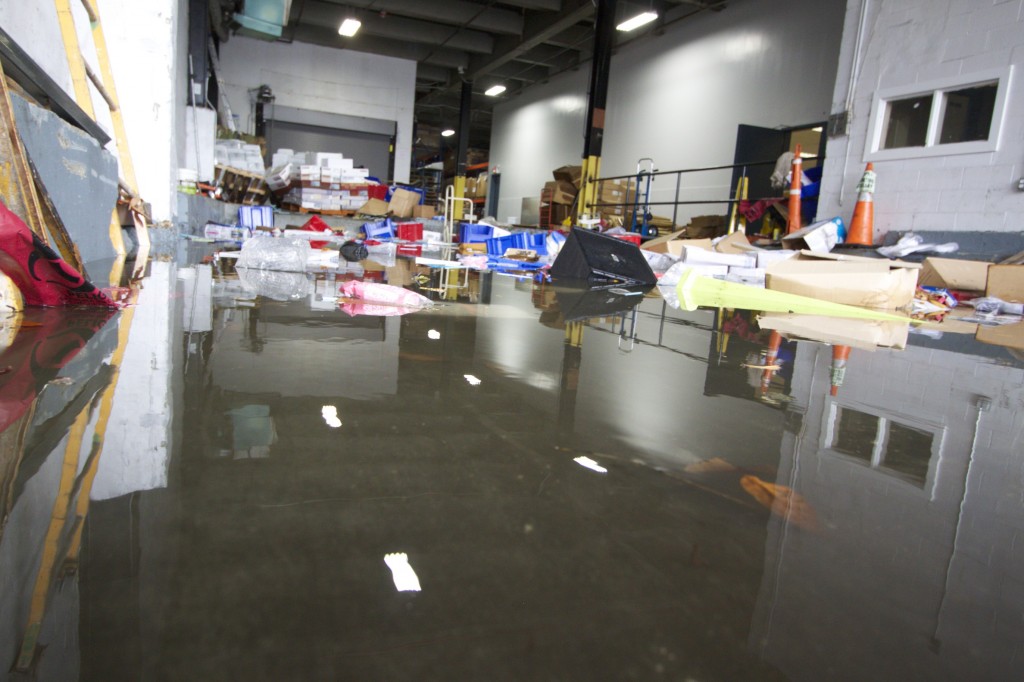
A disaster relief organization in the low-lying Hunts Point area of the Bronx experienced heavy flooding and a challenge to distribute supplies. (COLEEN JOSE/The Bronx Ink)
Early this morning, when Tim Reeve opened the storehouse of the disaster relief organization World Vision in Hunts Point, he saw devastation up close: water from Sandy had flooded the building.
A delivery truck was submerged in three-feet-deep water. Pink collared-shirts inside plastic bags floated beside cases of pencils and hygiene kits that awaited delivery from the Hunts Point warehouse to hard-hit areas in New York and the region.
As emergency response teams rush to rescue residents from flooding and fires, organizations that are gearing up to join the efforts are facing challenges in the storm’s aftermath. In Hunts Point, a flood-prone area in the Bronx, organizations like World Vision and major food distribution companies are struggling to resume operating.
“At this point, we’re trying to do emergency response, but right now, it appears that we’re in a disaster ourselves,” said Reeve, World Vision’s storehouse manager for New York. Reeve estimates that supplies will be ready for distribution by Thursday and that the warehouse may move to an alternative space.
The extent of Hurricane Sandy’s devastation on millions of residents from the shores of North Carolina to Maine is still being determined, as floods, power outages and snow continue to displace thousands of residents from their communities. Eight million people in 15 states remain without electricity.
The federal government estimates $20 billion in damages from the storm.
Sandy hits the industrial zone in Hunts Point, Bronx from Adam Perez on Vimeo.
Inside World Vision’s office, a fire alarm blared as a project coordinator pointed to a water line three feet above the soaked carpet. A kitchen refrigerator was flipped on its side. Relief supplies were strewn across the warehouse.
Reeve did not expect water from the East River to reach the storehouse, which is located near a boardwalk in Barretto Park. But the park’s benches were already underwater as the storm raged and the sea rose on Monday. There were no sandbags to buffer the area from the surge.
Chad Narine, an MTA track worker, witnessed an electrical transformer exploding underneath the sidewalk outside of the MTA compound on Tiffany Street around 11:30 p.m. on Monday. “I was standing in the transit yard inside,” said Narine, 34, “when I heard a loud boom and saw a white a flash.”
Steam continued to rise from a hole in the sidewalk on Tuesday while an emergency vehicle from ConEdison, which provides electricity, gas and steam, monitored the damaged transformer.

“New York needs to be more careful with powerful storms like these,” said Adama Makouyate, an employee at a food-distribution plant in a flood-prone area of Hunts Point. (COLEEN JOSE/The Bronx Ink)
New York City’s Office of Emergency Management lists the low-lying area in Zone B, meaning it faces a moderate risk of flooding and likelihood of evacuation during storm surges and hurricanes. But the flooding in the area could have a major impact on the entire metropolitan area. Hunts Point is home to the region’s largest-food distribution center.
Everyday, more than 15,000 delivery trucks come in and out of the area’s produce, meat and seafood market, which supplies much of the city and surrounding region’s grocery markets and restaurants.
In the Co-Op Meat Market, warehouse manager Milton Pinto recalled being stranded with 31 fellow workers before the storm neared landfall. Most workers lived in Brooklyn and the Bronx. They didn’t arrive home until 5 p.m the next day.The meat market closed operations on Tuesday for the first time.
Raphael Candelario, a worker at New Fulton Fish Market, was one of two employees in the distribution plant while the waves pummeled the rocky shores. Candelario, 47, arrived to monitor the site at 5 a.m. Monday. “Water came up to the plant between 3 to 4 a.m.,” said Candelario. The river’s waters also reached the top of a staircase in a pier house next to the market.
In a nearby food distribution plant, Sultana Distribution Services Inc., a security guard surveyed damages from the storm. Adama Makouyate, 45, dressed in a red raincoat and black pants, expressed awe at the 22 stone barriers that were blown 10 to 20 feet away from the edge of a lot facing the East River. The barriers, which weigh more than a ton, lined the lot to protect the distribution plant from the surge. Metal fences lay flat on the pavement, indicating the hurricane’s wind power, which exceeded 70 miles per hour.
Hurricane Sandy exposed the city’s lack of storm barriers and infrastructural safeguards. During separate news conferences today, Gov. Andrew Cuomo and Mayor Michael Bloomberg discussed plans to armor the city from storm surges and sea level rise. Cuomo proposed the possibility of building levees in Lower Manhattan.
“We have a 100-year flood every two years now,” said Cuomo. “The construction of this city did not anticipate these kinds of situations. We are only a few feet above sea level.”
Additional reporting by Adam Perez and Jan Hendrik Hinzel.
